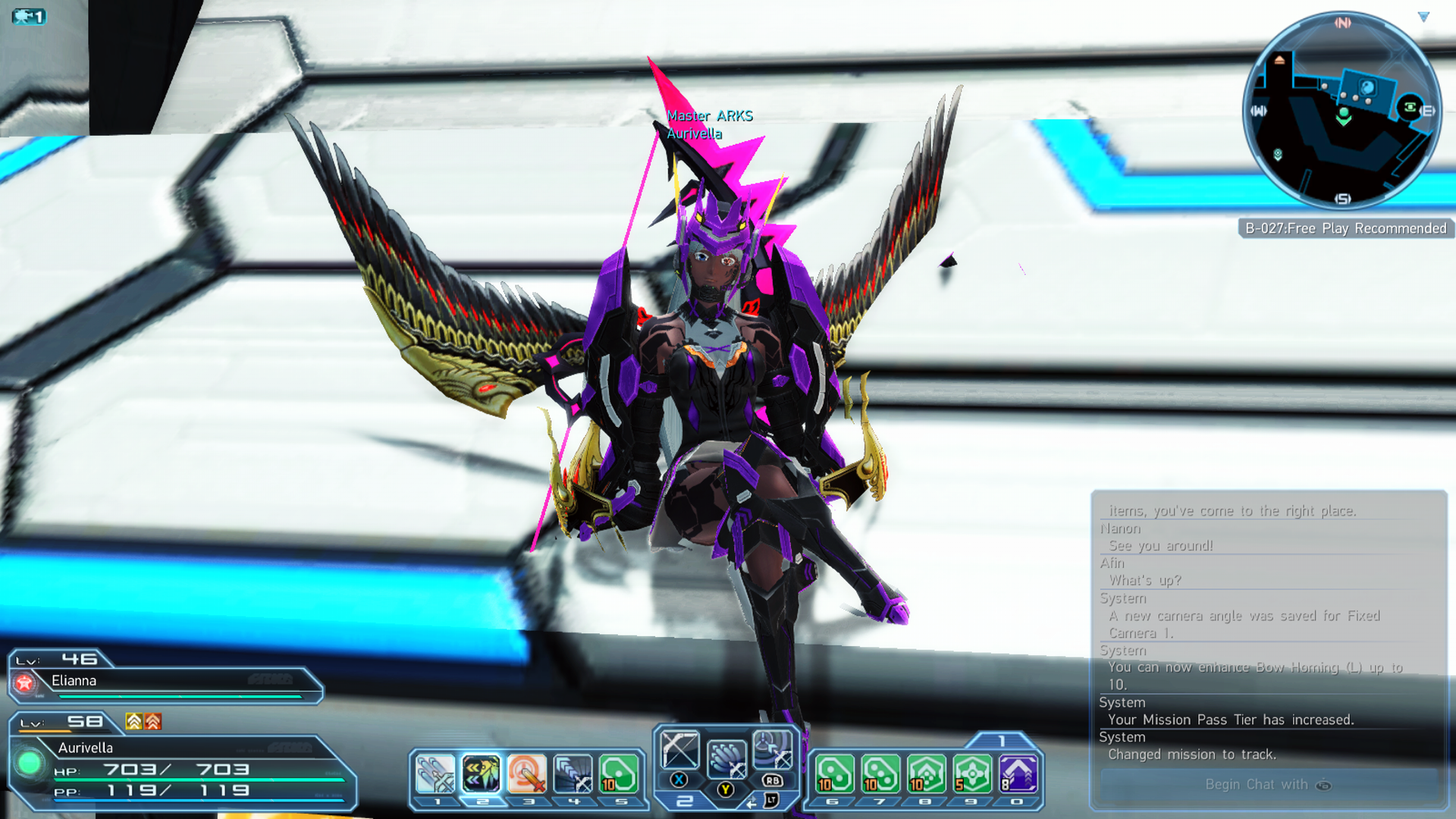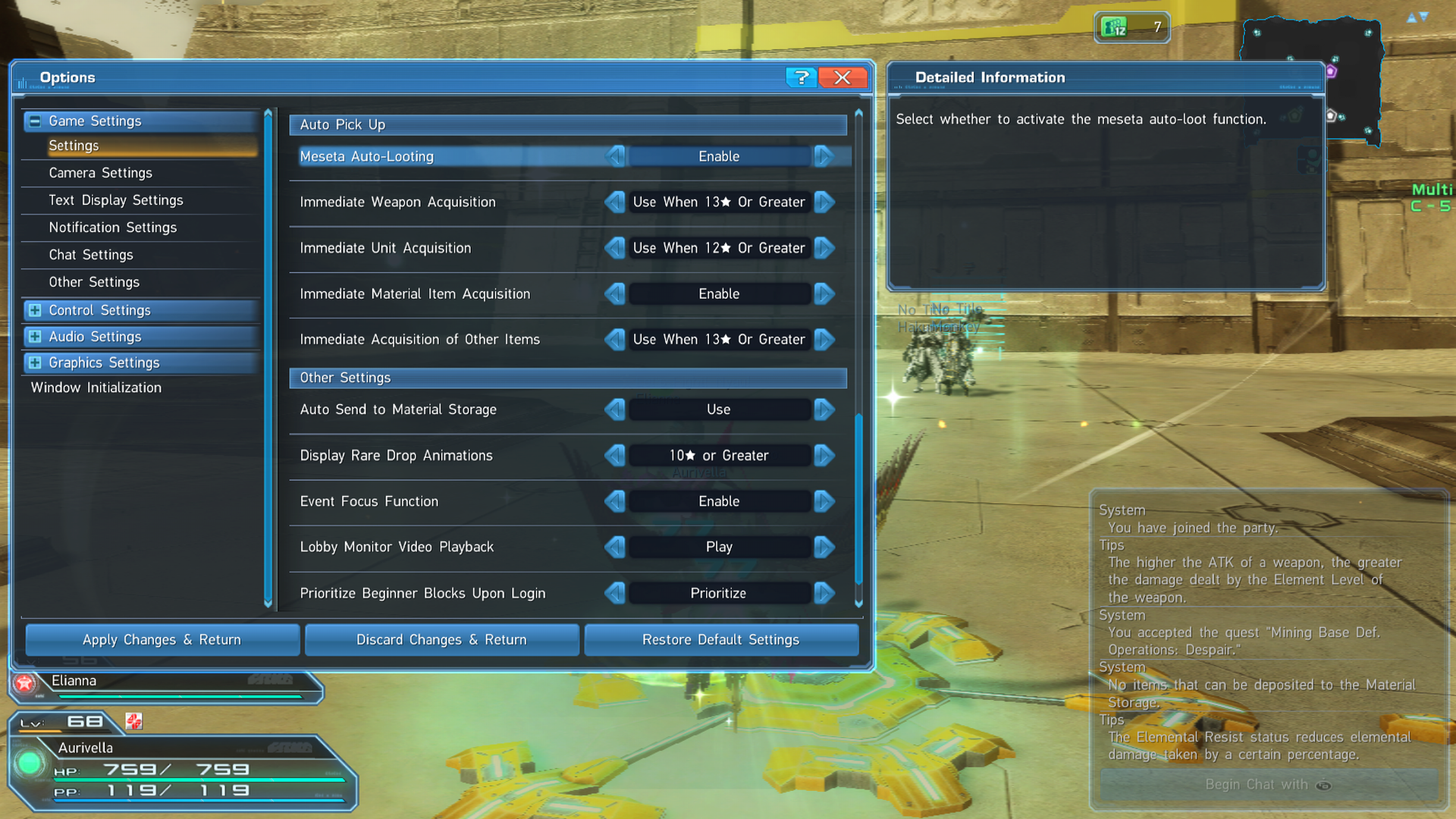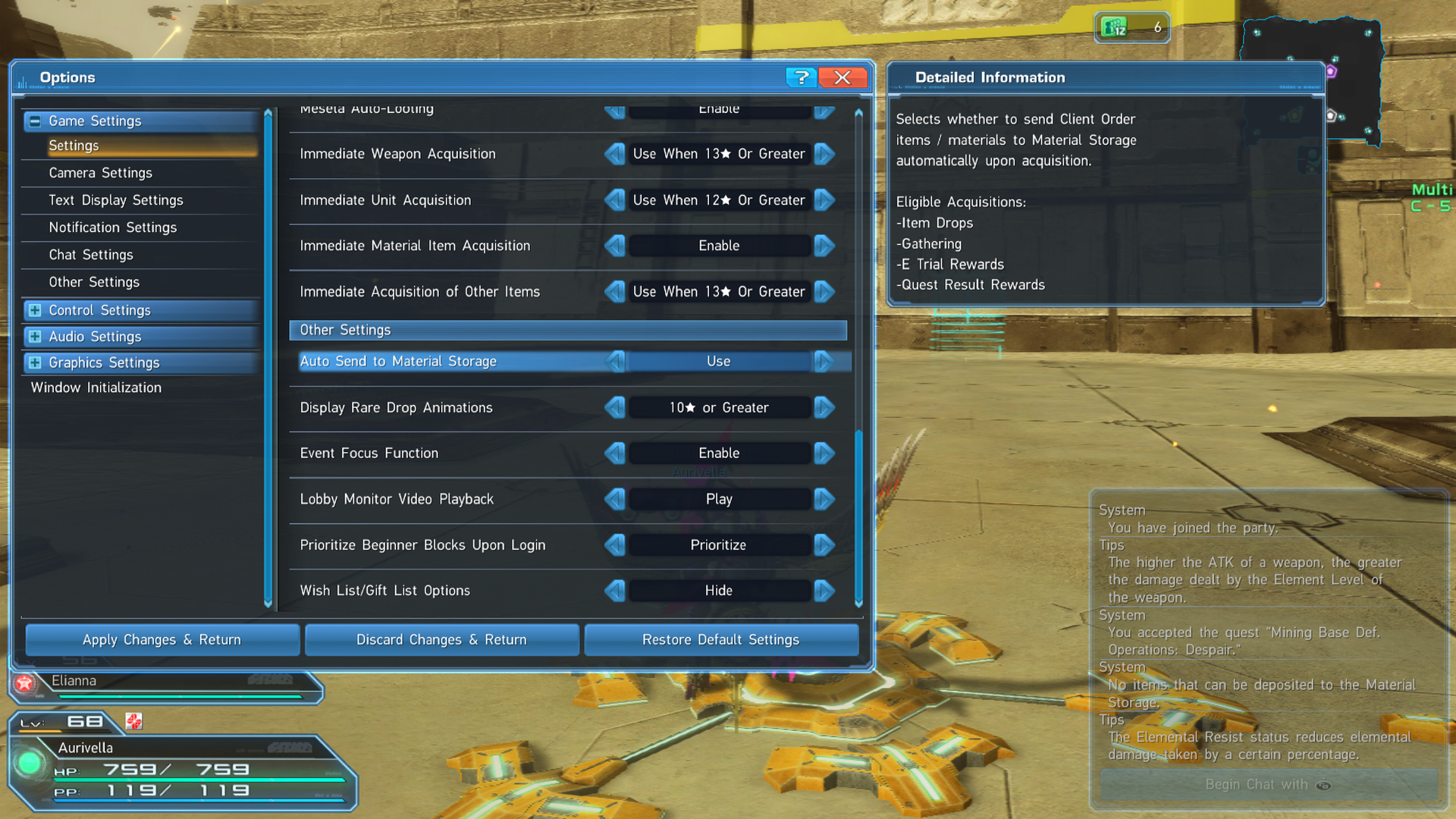Greetings, ARKS!
With Phantasy Star Online 2 (aka PSO2) launching for PC on May 27, 2020, maybe you’re looking to pick it up. This guide is intended to a gentle introduction to the game written by someone who’s relatively new (slightly below max level), who just started playing the game when it came out on Xbox in April 2020.
As a free-to-play game, there are a few things that will come across as especially annoying. I’m not going to suggest you jump there immediately, but know that the Pay to be Less Annoyed section is there specifically to address these issues.
Let’s get you on your way!
First Steps
When you launch the game for the first time, you’ll be asked to select a ship. This is important: if you’re trying to play the game with friends, talk to each other and make sure you all pick the same ship. You can move later, but it has a cost.
Picking your race/gender and class. The race/gender doesn’t make a huge difference to stats, but it’s not zero. Unless you’re trying to minmax (this is probably not the guide for you?), I suggest just picking what fits the character you want. The class also doesn’t matter too much initially, since you can change it anytime later at the Class Counter. What class dictates early on is what weapons you can use, but eventually as you unlock photon arts and techniques (aka magic/abilities) and develop skill trees, you’ll find that there are better classes for your preferred playstyle.
Next you’ll enter the character creator. This is expansive. Take your time to make your character look the way you want, and take advantage of being able to customize outfit colors. This will not be something that is free to do later; a few notable exceptions are that you can freely change hairstyle, accessories, and outfits (not colors).
You’ll be thrown into a tutorial mission. After you complete it, you’ll end up in the ARKS ship lobby, at which point you’ll be guided through a number of other tutorials.
A lot of tutorials.
It can be a bit overwhelming, and at first it’ll feel like there’s too much going on in the interface. One thing that this game does suffer from early on is there’s a fair bit of reading needed to get a handle on what’s happening.
Ship Stuff
While you’re on the ship, here are a few things to note right away.
Areas
There are a few major areas:
- ARKS ship lobby
- shopping plaza
- Franca’s Cafe
- alliance quarters
- personal quarters
- casino
The ARKS ship lobby and the shopping plaza are going to be the most relevant starting out, since that’s where you’ll initiate quests from, get client orders (basically bounties in Destiny 2 parlance), and buy/sell items to NPCs.
Blocks and Partying
Each ship has different instances of the main areas. You must be in the same block as somebody else to party together. Block 1 seems to be the noisiest in terms of average population and chatter. You can switch blocks by using any of the elevators. If your friend is online, you can select them from the menus and transfer to their block.
You can invite people to your party. You can’t join someone’s party without an invite if they’re in the ARKS ship, but you can join if they’re questing from the quest counter if you know what quest they’re in.
Quest Counter
This is where you launch basically every mission from. It’s in the ARKS ship lobby just to the right of the entrance to the gateway ship. Your main form of initial progression is to launch expeditions or sub quests that you haven’t completed yet.
Each quest is instanced. Many of them have multi-party areas. Typically, boss fights at the end of a quest are single-party.
Quest Selection
When you select a quest, you’ll sometimes notice two buttons at the bottom:
- Search Multiple Blocks and Accept
- Accept in Current Block
Search Multiple Blocks and Accept will look for other parties running the same quest on different blocks. It’ll match you, transfer you to another block, and throw you directly into the gateway ship.
Accept in Current Block will place you in a quest instance in your current block (creating a new one if none exists already), and you’ll remain at the quest counter afterward. You can then enter the gateway ship at your leisure.
By default, your party is joinable by anyone. There are two checkboxes to restrict who can join your party from the quest selection menu, you can allow friends only or alliance members only. You can also forbid joining from the main party menu directly if you feel like playing solo.
More Quest Types
As you progress, you’ll unlock the ability to run Time Attack, Advance Quests, Extreme Quests, and more.
Special note: Urgent quests will pop up occasionally, where all ARKS agents are called to help! You’ll pretty much always want to do these initially, and they remain rewarding at different difficulty levels for both EXP and loot. They vary a fair bit, including things like “kill this boss”, “fight off an attack on another ship”, “defend this base against waves of enemies”, and more.
Story missions are solo. The whole thing is a bit strange, as they are mostly dialogue initially. Then occasionally it’ll be several long missions strung together, then back to dialogue. It’s worth checking out if you want to know more about what’s actually going on in PSO2, but you don’t really have to engage in it in order to play stuff with other people.
ARKS Missions
When you complete missions, you have to turn them in from the menu. If you don’t do that, and there’s a next mission that unlocks after the one you’re on, it won’t give you the next mission step.
Client Orders
Characters all over the ARKS ship have client orders for you to complete. This is by far the fastest way to level up through about levels 30-40.
To pick these up more efficiently, you can launch a quest, and as long as you initiate it in the current block, you can easily grab relevant ones before entering the gateway ship by opening your menus, going to the Client Orders menu, and selecting the Outstanding Orders in the Field of Ongoing Quests, you can see most of the relevant orders to the area you’re going to be questing in. Note that this is mostly filtered by area and level, so there will be some client orders listed that may not apply to your specific quest.
You have to turn in client orders to the requester. They’ll be marked on the map after being completed, which makes it easier to turn in.
Class Counter
This is where you can switch classes at will. Eventually you’ll unlock the ability to have a subclass, which levels up independently.
Having a set subclass allows you to significantly benefit from some of that class’s skill tree (some skills only work when the class is your main class).
There’s also a Loadouts menu here, where you can save your current equips. This is very useful to save/load equips when changing classes so that you can restore your previous gear setup.
A significant difference from some other MMOs is that PSO2 classes are pretty much all DPS classes to some degree. While there are niches (Hunters have higher survivability, Techters are better at support, etc.), there isn’t quite the same kind of extreme specialization that you get in some games; being a pure healer or tank isn’t really a thing.
When you talk to the Class Counter, and go to add skills, you’ll notice that you have one skill tree per class. Select one of these trees, and you’ll get two options:
- Custom Setup
- Recommended Setup
I advise against “Recommended Setup”, since it will automatically assign skills, and probably not the way you want. Use Custom Setup to distribute skill points manually. There’s no penalty to waiting, so don’t feel like you have to spend your new points immediately. Note that you cannot generally undo skill selection (there are special items distributed very rarely), so choose carefully. Consider looking up and following a guide. The PSO2 Skill Simulator is great for exploring builds!
Each skill tree has an independent pool of skill points, so your points allocated to, say, Fighter, don’t draw from the same pool as those for Ranger.
Combat
I haven’t played enough of other characters than Bow Braver to get too in-depth, but here are some basics!
After every attack, there will be a red-tinged circle that appears briefly around your character. If you activate your next attack while it’s still visible, it’ll make a different sound when you attack, indicating that you have performed a “perfect attack”. This increases damage by around 15%.
Some class+weapon combos have a focus gauge. As you land more attacks, the focus gauge builds, and this changes how some of your photon arts (PA) behave when activated, making them more powerful. Using a PA will consume some focus.
Landing regular attacks (also known as “just attack” or JA) will replenish photon points (PP). Some characters have ways to increase the speed of their regular attack, which can be very good for PP regen.
Lock-on targeting can help to keep your attacks focused on a single enemy, and avoid auto-targeting going for something else.
Over-the-Shoulder view can be good for ranged attacks when you’re out of range for normal or locked targeting to work.
Essential Options
Set these auto pickup and other settings as shown:
Raising a Mag
At some point you’ll get a Mag license, and then you’ll get a Mag, which is a little floating robot that accompanies you. You feed your mag items to raise its stats. Unlike weapon and unit equips, your mag’s stats apply to your base stats and so affect what equipment you can use.
You can preview how feeding your mag a given item will change its stats. Until you fill a bar to threshold, causing the level to go up, there is no effect, so you can carefully pick items to maximize boost to the specific stat you want.
It seems to be a common strategy advised in most guides to go for a pure S-ATK, R-ATK, or T-ATK mag.
Pay to be Less Annoyed
Like any free-to-play game, PSO2 has a number of design aspects that are intended to convince you to spend money. Some of them are more exploitative, and some are incredibly worthwhile. Judicious use of money can be a good way to “buy” your way to feeling like this is a regular paid game instead of a free-to-play MMO, drastically reducing some of the inventory annoyance factor.
Some upgrades that cost you are limited-time, and some are permanent. The limited-time upgrades are stated clearly. The permanent ones are typically limited to a single character.
Currencies
There are three main currencies in the game.
Meseta is the primary in-game currency. You get this through just playing and picking up off the ground after defeating enemies.
Star Gems (aka SG) are possible to acquire in-game to a limited degree, but to get large amounts, you will need to pay real money. Earning titles and completing story missions will award you these fairly generously early on, and if you enjoy the game to play it past that point, you’ll likely finding yourself acquiring enough to keep the essential upgrades going.
ARKS Cash (aka AC) can only be acquired using real money.
High value items
Your default inventory size is 50, and this includes all of your equipped items, upgrade items, gathering/fishing materials, enemy drops, collectibles, cosmetics, etc. 50 will feel painfully small within a couple hours of starting the game.
There are two quick ways to address this:
- Buy material storage 30 day ticket for 300 SG.
- Buy inventory increase in increments of 10 for 350 AC (US$3.50). This applies to 1 character only.
Material storage is the more important one of these two.
When you start out there are only three tiers of storage:
- inventory, which is on your character (starts at 50 items)
- default storage, which is shared across characters (200 items)
- character storage, which is character-specific as the name suggests (starts at 300 items)
The biggest pain point here is inventory at 50, since you have to constantly shuffle stuff around. Material storage eliminates most issues by giving you a 1500 item storage that has special properties:
- you can auto bulk move to it at storage consoles
- harvesting and fishing can be set up to automatically place items in material storage
- vendors can see materials in material storage; i.e, you don’t have to move things to your inventory. This is the best part, since you don’t have to shuffle things around nearly as much.
Gold Mission Pass
If you’re enjoying the game quite a bit and planning to play more, pick up the gold mission pass which you can get for star gems in the SG store. This is kinda like what’s called a season pass or battle pass in other games. It’ll let you get some fun cosmetics and some decent in-game items. Unlocking tiers will also return star gems to you at certain levels. Tier Missions unlock this the fastest.
Final Words
This is still something of a work in progress; expect more updates over the coming days! Also, there are many other tutorials that go into much more depth, I encourage you to check them out too.



